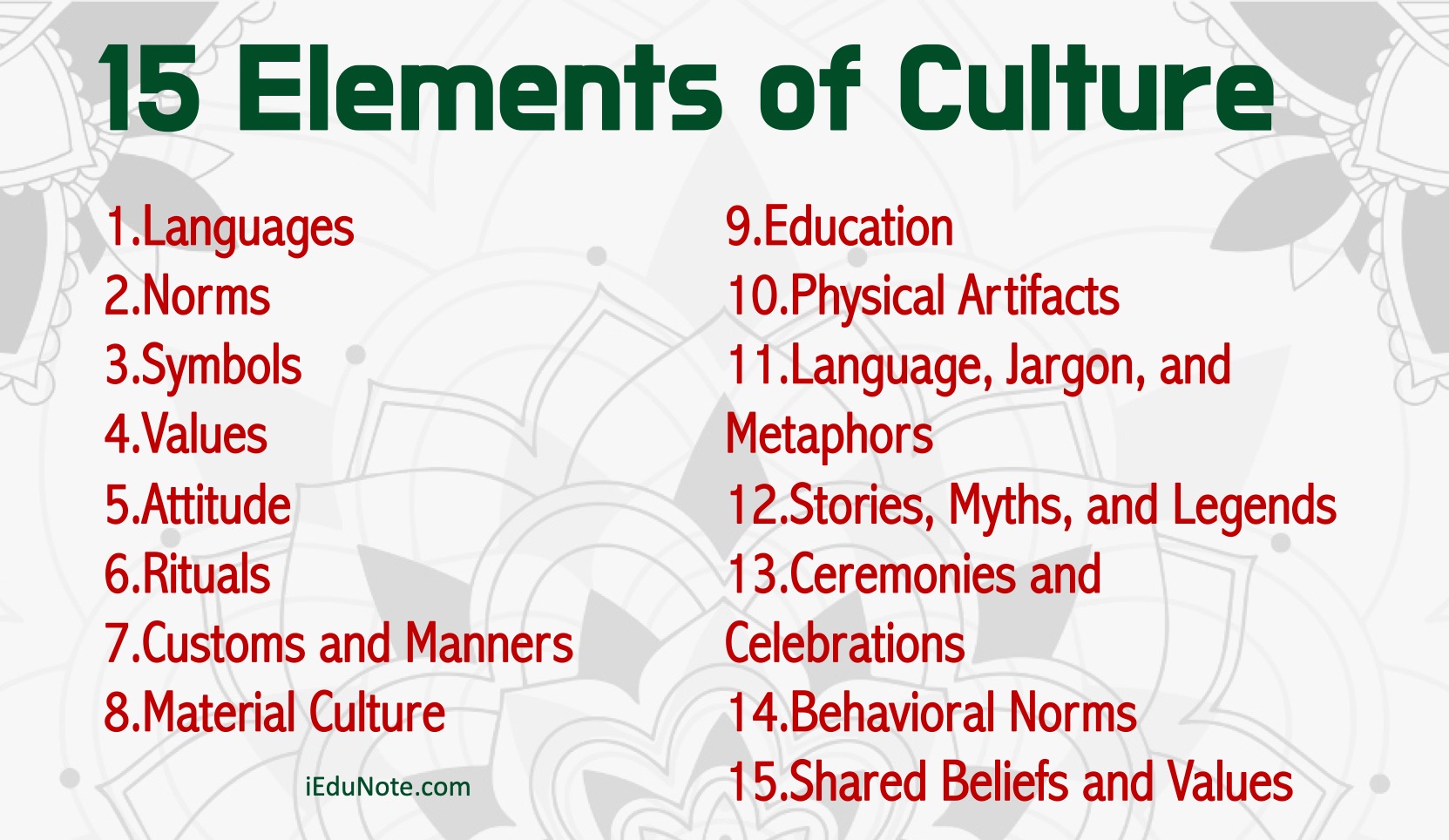Culture is transmitted to employees in many ways. The most significant are stories, rituals, material symbols, and language. Society’s culture also comprises the shared values, understandings, assumptions, and goals learned from earlier generations, imposed by present members of society, and passed on to succeeding generations.

Discover the 15 Key Elements That Shape Societies. From language and rituals to values and symbols, delve into the essence of human behavior.
Languages
It is a primary means used to transmit information and ideas. Knowledge of the local language can help because-
- It permits a clearer understanding of the situation.
- It provides direct access to local people.
- Understanding of implied meanings.
Religion: The spiritual beliefs of a society are often so powerful that they transcend other cultural aspects. Religion affect-
- The work habit of people
- Work and social customs
- Politics and business
Norms
Cultures differ widely in their norms, standards, and expectations for behavior. Norms are often divided into two types, formal norms, and informal norms.
Formal norms, also called mores and laws, refer to the standards of behavior considered the most important in any society.
Informal norms, also called folkways and customs, refer to standards of behavior that are considered less important but still influence how we behave.
Symbols
Every culture is filled with symbols of things that stand for something else, which often suggests various reactions and emotions.
Some symbols are actually types of nonverbal communication, while other symbols are, in fact, material objects.
Values
Values are a society’s ideas about what is good or bad, right or wrong – such as the widespread belief that stealing is immoral and unfair.
Values determine how individuals will probably respond in any given circumstance.
Attitude
Attitude is a persistent tendency to feel and behave in a particular way.
Actually, it is the external displays of underlying beliefs that people use to signal to other people.
Rituals
Rituals are processes or sets of actions that are repeated in specific circumstances and with a specific meaning. They may be used in rites of passage, such as when someone is promoted or retires.
They may be associated with company events, such as the release of a new event. They may also be associated with a day like Eid day.
Customs and Manners
Customs are common and established practices. Manners are behaviors that are regarded as appropriate in a particular society. These indicate the rules of behavior that enforce ideas of right and wrong.
They can be traditions, rules, written laws, etc.
Material Culture
Another cultural element is the artifacts, or material objects, that constitute a society’s material culture. It consists of objects that people make. Like-
- Economic infrastructure (transportation, communication, and energy capabilities)
- Social infrastructure (Health, housing, and education systems)
- Financial infrastructure (Banking, insurance, and financial services)
Education
It influences many aspects of culture.
Actually, culture is the entire accumulation of artificial objects, conditions, tools, techniques, ideas, symbols, and behavior patterns peculiar to a group of people, possessing a certain consistency of its own and capable of transmission from one generation to another.
Physical Artifacts
These are the tangible manifestations and key elements of organizational culture.
If you visit different organizations, you’ll notice that each is unique in terms of its physical layout, use of facilities, centralization or dispersion of common utilities, and so on.
This uniqueness is not incidental; instead, they represent the symbolic expressions of an underlying meaning, values, and beliefs shared by people in the organization. The workplace culture greatly affects the performance of an organization.
Language, Jargon, and Metaphors
These elements of organizational culture play an important role in identifying a company’s culture.
While language is a means of universal communication, most business houses tend to develop their own unique terminologies, phrases, and acronyms.
For instance, in the organizational linguistics code, “Kremlin” may mean the headquarters; in Goal India Limited, the acronym. J.I.T. (Just In Time) was jokingly used to describe all the badly planned firefighting jobs.
Stories, Myths, and Legends
These are, in a way, an extension of organizational language. They epitomize the unwritten values and morals of organizational life.
If you collect the various stories, anecdotes, and jokes shared in an organization, they often read like plots and themes, in which nothing changes except the characters.
They rationalize the complexity and turbulence of activities and events to allow for predictable action-taking.
Ceremonies and Celebrations
These consciously enacted behavioral artifacts help reinforce the organization’s cultural values and assumptions.
For example, Tata Steel celebrates Founder’s Day every year to commemorate and reiterate its adherence to the organization’s original values.
Stating the importance of ceremonies and celebrations, Deal and Kennedy (1982) say, “Without expressive events, culture will die. In the absence of ceremony, important values have no impact.”
Behavioral Norms
This is one of the most important elements of organizational culture. They describe the nature of expectations, which impinge on the members’ behavior.
Behavioral norms determine how the members will behave, interact, and relate with each other.
Shared Beliefs and Values
All organizations have their unique set of basic beliefs and values (also called moral codes), shared by most of their members. These mental pictures of organizational reality form the basis of defining the organization’s right or wrong.
For instance, in an organization, if the predominant belief is that meeting the customers’ demands is essential for success, any behavior that supposedly meets these criteria is acceptable, even if it violates the established rules and procedures.
Values and beliefs focus organizational energies on certain actions while discouraging other behavioral patterns.